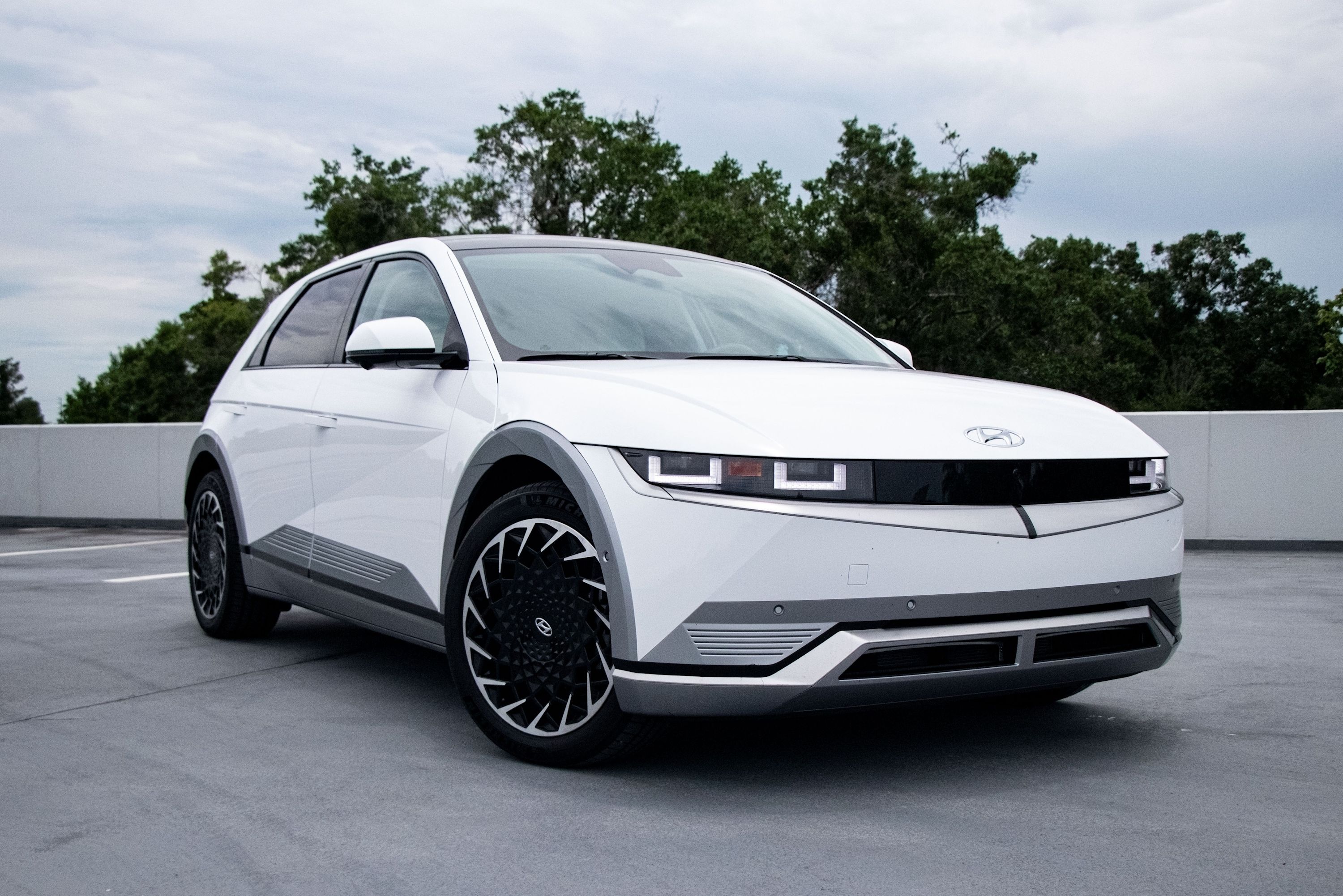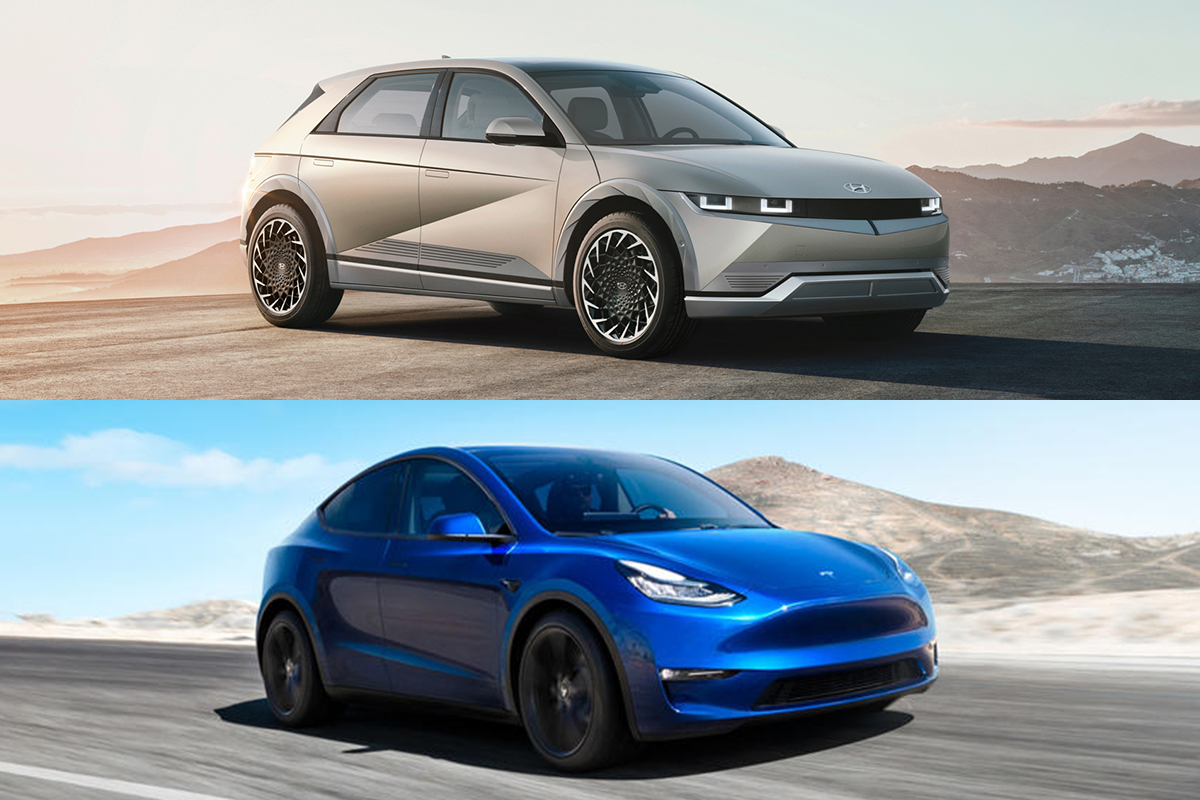
Three years ago, Hyundai trolled Tesla with a billboard ad for its new electric vehicle at the time, the Kona EV. Essentially, Hyundai made its intentions for taking on the giant of EVs blatantly clear. Fast forward to 2021, and Hyundai is even better prepared to take on Tesla following the launch of its Ioniq all-electric sub-brand and the sexy new Ioniq 5, the dramatic first product from this sub-brand. However, Tesla is also positioned for a battle at a lower price point with the existing Model Y crossover. The question is: should you immediately go knocking on Hyundai's door or is the Tesla Model Y still the EV to beat? Let's find out.
Exterior: Angles Vs. Curves
The Ioniq 5's taut, sharp-edged lines are in direct contrast to Tesla's rounded design philosophy and the smoother body of the Model Y. Hyundai bills its Ioniq 5 as a midsize crossover, although it appears more hatchback-like in profile.
There's nothing wrong with the Model Y's design, but the Ioniq 5 is now more futuristic in its appearance thanks to those 20-inch aero wheels, a clamshell hood, and block-shaped daytime running lights. At 182.5 inches, the Ioniq 5 is 4.5 inches shorter than the Tesla, as well as lower and narrower. As things stand now, the sportier Ioniq 5 gets our vote as the more evocative vehicle.
Interior: New-Age EV Minimalism
It almost seems to be a prerequisite for modern EVs to have simplified cabin designs that prioritize screens over traditional switches and buttons. Both have large displays, with dual 12-inch screens in the Ioniq 5 and a single 15-inch touchscreen in the Model Y. Hyundai still relies on a few buttons lower down whereas virtually everything must be managed via the Tesla's single screen. The Ioniq 5 employs various recyclable materials as well as eco-processed leather, whereas Tesla uses its own synthetic leather.
Tesla claims 68 cubic feet of enclosed trunk space, which exceeds the Ioniq 5's total utility space of about 56.5 cubes with its back seats folded. We were impressed with the amount of space in the Model Y, so it remains to be seen if the Ioniq 5 can match this with its sliding rear seat. The Hyundai also has a movable center console that improves ingress/egress and a distinctive lounge-like layout with a flat floor.
Performance And Range: Tesla Stays In Front
Tesla's performance figures are normally a step (or three) ahead of the competition, and that's the case here as well. Even the base Model Y Long Range with dual motors and all-wheel-drive takes just 4.8 seconds to reach 60 mph. The AWD Model Y Performance improves on this with a 0-60 mph time of only 3.5 seconds and a top speed of 155 mph. Tesla recently ditched the cheaper RWD Model Y Standard Range model, although apparently, it's still available "off menu" according to Elon Musk.
By contrast, the Ioniq 5 offers both RWD and AWD. The single-motor RWD model takes 8.5 seconds to reach 62 mph when paired with a 58-kWh battery, or 7.4 seconds with the 72.6-kWh battery. With dual electric motors, AWD, and the 72.6-kWh battery, the fastest Ioniq 5 will reach 62 mph in 5.2 seconds, getting it a bit closer to the base Model Y.
In terms of range, the Model Y Long Range can attain 326 miles on a single charge while the Performance variant has a range of 303 miles. Based on the WLTP cycle, the Ioniq 5 with the 72.6-kWh battery and 2WD will manage up to 298 miles. Once again, it falls short of the Model Y.
Hyundai says that using a 350-kW charger, the Ioniq 5's battery can be replenished from ten to 80 percent in 18 minutes, or 100 km (62 miles) of range can be achieved from a five-minute charge. Of course, Tesla offers its widespread Supercharger network; here, a 15-minute charge can provide 158 miles of range. Both will take far longer to charge using a regular household outlet.
Technology: Welcome To The Future
Hyundai has thrown some nifty tech at the Ioniq 5. Along with the dual 12-inch screens, it gets an augmented reality head-up display that the company says turns the windshield into a display screen. This is a feature not available on the Tesla. Both have many driver-assistance features and accident-avoidance technologies under the banner of Hyundai SmartSense and Tesla's Autopilot.
Impressively, the Ioniq 5 features V2L capability, meaning the car itself can charge electric devices like camping equipment or scooters. Tesla's Full Self-Driving Capability boasts autopark, auto lane-change assist, and even summon, whereby the car can drive itself to the driver.
Pricing: Watch This Space
This one is impossible to call at the moment as Hyundai has yet to reveal pricing for the Ioniq 5. However, it's safe to say that it'll be more expensive than the Kona Electric, and that crossover begins at $37,390. The Tesla Model Y starts at $48,990 for the Long Range and goes up to $60,990 for the Performance model. Based on these numbers, the two EVs could end up being similarly priced. However, while new Hyundai EVs still qualify for a federal tax credit of up to $7,500, Teslas do not.
Verdict: And The Winner Is?
Together with the Model 3, the Model Y has done a brilliant job of making Teslas more accessible to more customers. They look similar to their larger counterparts yet provide a mix of performance, charging infrastructure, and range that remains out of reach for most other automakers at this point in time. That's true for the Ioniq 5, which is simply outgunned by the quicker Model Y while failing to match its range numbers.
It's not quite as simple as a numbers game, though. The Ioniq 5 is a big first step for Hyundai and shows its dedication to EVs now and in the near future. As a piece of design, it is hard not to be won over and there's loads of technology to enjoy. If Hyundai can get the price right and the Ioniq 5 turns out to be good to drive, the Tesla's better performance may not be enough to see it walk away with all the spoils. We'll know more when the Ioniq 5 becomes available in the fall.

